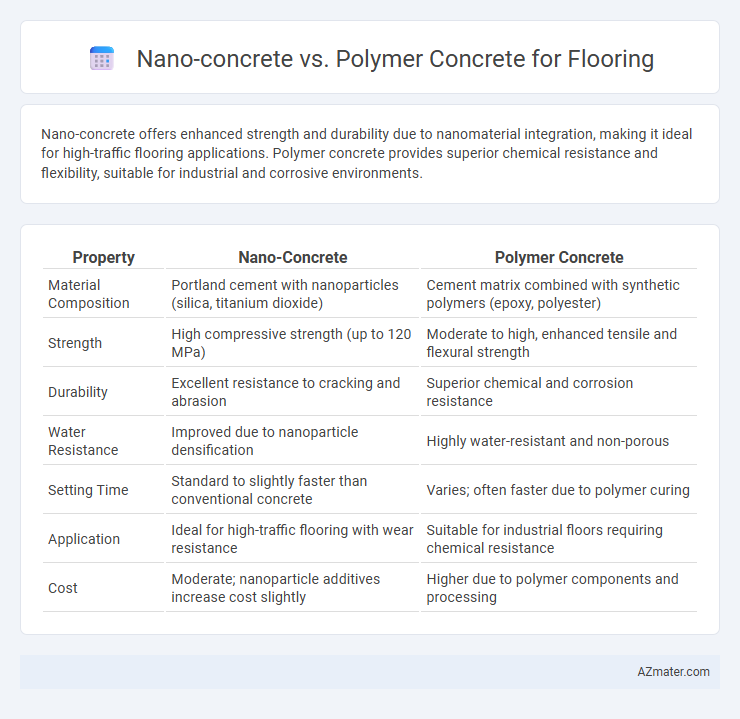Nano-concrete offers enhanced strength and durability due to nanomaterial integration, making it ideal for high-traffic flooring applications. Polymer concrete provides superior chemical resistance and flexibility, suitable for industrial and corrosive environments.
Table of Comparison
| Property | Nano-Concrete | Polymer Concrete |
|---|---|---|
| Material Composition | Portland cement with nanoparticles (silica, titanium dioxide) | Cement matrix combined with synthetic polymers (epoxy, polyester) |
| Strength | High compressive strength (up to 120 MPa) | Moderate to high, enhanced tensile and flexural strength |
| Durability | Excellent resistance to cracking and abrasion | Superior chemical and corrosion resistance |
| Water Resistance | Improved due to nanoparticle densification | Highly water-resistant and non-porous |
| Setting Time | Standard to slightly faster than conventional concrete | Varies; often faster due to polymer curing |
| Application | Ideal for high-traffic flooring with wear resistance | Suitable for industrial floors requiring chemical resistance |
| Cost | Moderate; nanoparticle additives increase cost slightly | Higher due to polymer components and processing |
Introduction to Nano-Concrete and Polymer Concrete
Nano-concrete incorporates nanoparticles such as nano-silica to significantly enhance mechanical strength, durability, and resistance to chemical attacks compared to traditional concrete. Polymer concrete utilizes polymeric resins as a binder instead of cement, resulting in superior adhesion, rapid curing, and high resistance to moisture and solvents, making it ideal for flooring applications in industrial environments. Both materials offer advanced performance characteristics but differ in composition, setting times, and specific resistance properties critical for long-lasting flooring solutions.
Composition and Material Properties
Nano-concrete incorporates ultra-fine nanoparticles such as nanosilica and nanoclay to enhance the microstructure, resulting in superior compressive strength, reduced porosity, and improved durability compared to conventional concretes. Polymer concrete replaces traditional cement binders with polymer resins like epoxy or polyester, providing exceptional chemical resistance, flexibility, and bonding strength suitable for industrial flooring applications. The nanomaterials in nano-concrete optimize particle packing and hydration processes, whereas polymer concrete's resin matrix delivers enhanced impact resistance and surface hardness, influencing material selection based on environmental and mechanical performance requirements.
Mechanical Strength Comparison
Nano-concrete exhibits superior mechanical strength compared to polymer concrete, with enhanced compressive and flexural strength due to its nano-silica and nano-clay additives that improve the microstructure. Polymer concrete offers good mechanical properties through its resin binders, providing high tensile strength and chemical resistance but typically lower compressive strength than nano-concrete. For flooring applications demanding high load-bearing capacity and durability, nano-concrete outperforms polymer concrete in overall mechanical robustness.
Durability and Longevity in Flooring Applications
Nano-concrete exhibits superior durability in flooring applications due to its enhanced microstructure, which significantly reduces porosity and improves resistance to abrasion and chemical attacks. Polymer concrete offers excellent longevity with high tensile strength and flexibility, making it resistant to cracking and thermal cycling in demanding environments. While nano-concrete provides exceptional hardness and wear resistance, polymer concrete excels in impact resistance and long-term stability under dynamic loads.
Chemical Resistance and Environmental Impact
Nano-concrete offers superior chemical resistance due to its enhanced microstructure, reducing porosity and preventing chemical ingress, making it ideal for flooring exposed to harsh chemicals. Polymer concrete incorporates synthetic resins, providing excellent chemical resistance and durability, but its production involves higher emissions of volatile organic compounds (VOCs), impacting environmental sustainability. Environmentally, nano-concrete is favored for its lower carbon footprint and potential use of industrial byproducts, whereas polymer concrete's reliance on petrochemical resins raises concerns about non-renewable resource consumption and long-term ecological effects.
Installation Processes and Curing Times
Nano-concrete flooring requires precise mixing and application techniques to ensure uniform dispersion of nanoparticles, often involving specialized equipment to achieve optimal strength and durability. Polymer concrete flooring benefits from faster installation due to its pre-mixed resins and aggregates, enabling quicker setting times and reducing labor costs. Curing times for nano-concrete typically range from 7 to 14 days for full strength, whereas polymer concrete floors can often cure within 24 to 48 hours, allowing for faster project turnaround.
Cost Analysis: Nano-Concrete vs Polymer Concrete
Nano-concrete offers higher initial material costs but provides superior durability and reduced maintenance expenses over time, making it cost-effective for long-term flooring projects. Polymer concrete generally costs less upfront with faster curing times, yet may incur higher repair and replacement costs due to lower resistance to chemical and mechanical wear. Evaluating lifecycle costs reveals nano-concrete as a more economical choice for high-traffic or industrial flooring applications despite the premium price.
Suitability for Industrial and Commercial Floors
Nano-concrete offers exceptional durability and high resistance to wear and chemical attacks, making it ideal for heavy-duty industrial floors with intense mechanical stress. Polymer concrete provides excellent flexibility and superior bonding properties, well-suited for commercial floors requiring resistance against abrasion and exposure to moisture. Both materials enhance floor longevity, but nano-concrete withstands extreme industrial conditions better, while polymer concrete excels in environments with moderate traffic and aesthetic demands.
Maintenance and Lifecycle Performance
Nano-concrete flooring exhibits superior durability and resistance to abrasion, significantly reducing maintenance frequency compared to conventional polymer concrete. The nano-scale additives enhance microstructure density, leading to longer lifecycle performance by mitigating cracks and chemical attacks. Polymer concrete, while offering good initial strength and chemical resistance, often requires more frequent upkeep and may experience reduced longevity under heavy mechanical stress.
Future Trends and Innovations in Concrete Flooring
Nano-concrete incorporates nanoparticles to enhance strength, durability, and self-healing properties, making it increasingly favored for advanced flooring applications. Polymer concrete, combining resin binders with aggregates, offers superior chemical resistance and rapid curing times, ideal for industrial flooring innovations. Future trends emphasize integrating nanotechnology with polymer matrices to create hybrid flooring solutions that maximize performance, sustainability, and lifespan.

Infographic: Nano-concrete vs Polymer concrete for Flooring
 azmater.com
azmater.com